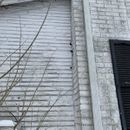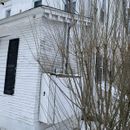Water getting in
I’m doing a small renovation, ripped down the sheetrock and old fiberglass batting and discovered the inside surface of the exterior wall is wet.
The framing on the external wall is full-size 2×4 (actually, 2″ x 4″, because it’s old), with pine boards attached to the outside. Exterior to the pine boards appears to be some form of concrete/stucko with a brick pattern on the outside.
I found a couple of holes, but that would only explain (I think) a portion of the wet area.
And, the wet area is only from about 7′ above floor and down; that is, the very top is dry, which, to me, says the water is not coming from a higher point, but somehow through the exterior vertical surface of the wall.
Visually (other than the couple of holes), the surface looks and feels fine.
Can anyone advise what this could be and what my next steps should be?
I’m attaching some pictures.
Thank you!
GBA Detail Library
A collection of one thousand construction details organized by climate and house part














Replies
One more pic
It could be condensation. If the interior doesn't have an air barrier and a vapor barrier, warm moist interior air can flow through the insulation. When it reaches a cold part of the wall condensation happens.
That's a great suggestion, and always something I'll consider.
In my case, the water is limited to a very specific area that is not in any way different as far as insulation, vapor/water barrier, or inside heat than the area that is completely dry. I think this would rule out condensation (right?).
Thank you!
It seems like a bulk water leak at the inside corner where the two dissimilar exterior materials meet. If the two types of masonry(?) aren't integrally bonded they need to be sealed and resealed every so many years. It also sounds like the assembly may be lacking asphalt felt or any other water control layer. That's difficult/impossible to remedy without fully recladding or residing the exterior from what you've described.
The insulation likely came later in the life of the structure. Old buildings could sometimes get away without a water control layer if it also lacked insulaton because enough heat gets blasted through the assembly in summer and winter to dry things out.
I'm pondering whether the exterior materials are dissimilar or not. The outermost layer is a stucko type faux brick that is the same in both directions from that corner.
But, that front room was added many years after the original construction of the house. In fact, that front room was part of the front porch originally.
So, everything except the most exterior layer is dissimilar.
If the wetness was just in that corner, I'd think there is simply a break (opening) in the exterior layer in that area. But the wetness continues towards the front of the house to the new front corner.
I suspect that was no water control layer installed under the stucko exterior.
Is there any way fix this without ripping down the exterior layer of stucko and installing a water control layer, and then either siding or stucko?
Thank you!
Not to my awareness, no. I think to properly integrate a water control layer with adequate drainage you would need to reside. Lots of ways to go about it though, doesn't have to break the bank, but for the longevity of the house it's highly advisable.
Thank you very much.